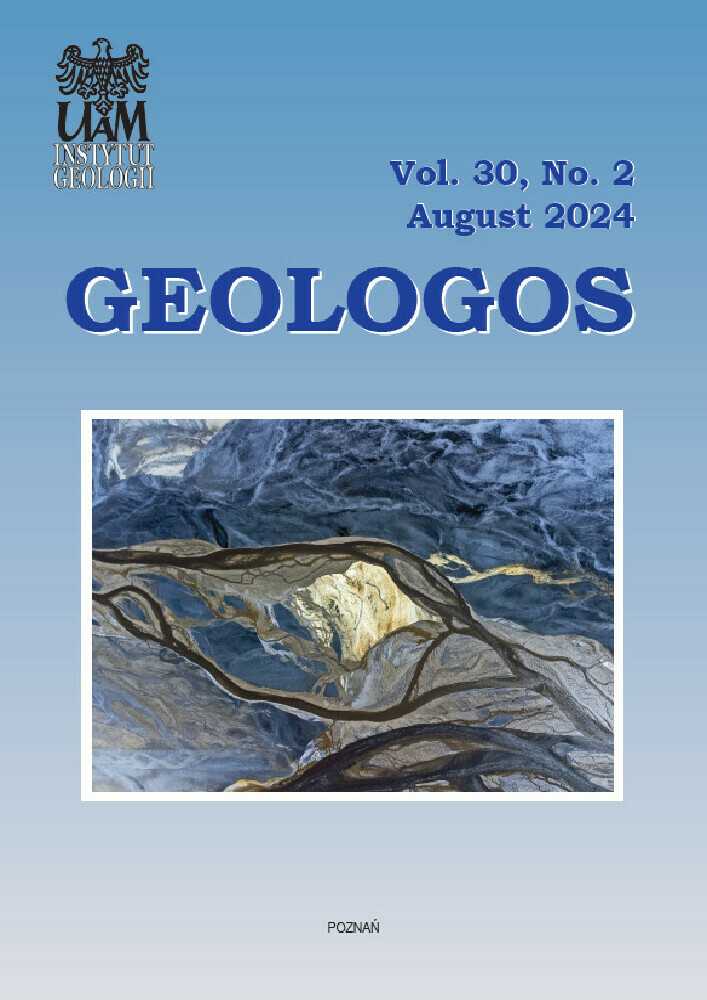References
Zieliński, T., 1982. Współczesne przepływy wysokoenergetyczne, ich osady oraz próba nawiązania do modelu depozycji stożków napływowych [Contemporary high-energy flows, their deposits and an attempt to refer to the model of alluvial fan deposition]. Geologia, Katowice 6, 98–110.
Zieliński, T., 1992. Proglacial valley facies of the Silesian Upland - genetic factors and their sedimentological effects. Geologia Sudetica 26, 83–118.
Van Loon, A.J., Brodzikowski, K. & Zieliński, T., 1995. Shock-induced resuspension deposits from a Pleistocene proglacial lake (Kleszczów Graben, Central Poland). Journal of Sedimentary Research A65, 417–422. DOI: https://doi.org/10.1306/D42680DB-2B26-11D7-8648000102C1865D
Zieliński, T. & Goździk, J., 2001. Palaeoenvironmental interpretation of a Pleistocene alluvial succession in central Poland: sedimentary facies analysis as a tool for palaeoclimatic inferences. Boreas 30, 240–253. DOI: https://doi.org/10.1111/j.1502-3885.2001.tb01225.x
Krzyszkowski, D. & Zieliński, T., 2002. The Pleistocene end moraine fans: controls on their sedimentation and location. Sedimentary Geology 149, 73–92. DOI: https://doi.org/10.1016/S0037-0738(01)00245-7
Zieliński, T., 2003. Catastrophic flood effects in alpine/foothill fluvial system (a case study from the Sudetes Mts, SW Poland). Geomorphology 54, 293–306. DOI: https://doi.org/10.1016/S0169-555X(02)00362-8
Zieliński, T. & Van Loon, A.J., 2003. Pleistocene sandur deposits represent braidplains, not alluvial fans. Boreas 32, 590–611. DOI: https://doi.org/10.1080/03009480310004170
Gradziński, R., Baryła, J., Danowski, W., Doktor, M., Gmur, D., Gradziński, M., Kędzior, A., Paszkowski, M., Soja, R., Zieliński, T. & Żurek, S., 2003. Vegetation-controlled modern anastomosing system of the upper Narew River (NE Poland) and its sediments. Sedimentary Geology 157, 253–276. DOI: https://doi.org/10.1016/S0037-0738(02)00236-1
Zieliński, T., 2007. The Pleistocene climate-controlled fluvial sedimentary record in the Belchatow mine (central Poland). Sedimentary Geology 193, 203–209. DOI: https://doi.org/10.1016/j.sedgeo.2005.06.016
Gruszka, B. & Zieliński, T., 2008. Evidence of a very low-energy fluvial system: a case study from dinosaur-bearing Upper Triassic rocks of S Poland. Geological Quarterly 52, 239–252.
Pisarska-Jamroży, M. & Zieliński, T., 2014. Pleistocene sandur rhythms, cycles and megacycles: Interpretation of depositional scenarios and palaeoenvironmental conditions. Boreas 43, 330–348. DOI: https://doi.org/10.1111/bor.12041
Pawłowski, D., Kowalewski, G., Milecka, K., Płóciennik, M., Woszczyk, M., Zieliński, T., Okupny, D., Włodarski, W. & Forysiak, J., 2015. A reconstruction of the palaeohydrological conditions of a flood-plain: a multi-proxy study from the Grabia River valley mire, central Poland. Boreas 44, 543–562. DOI: https://doi.org/10.1111/bor.12115
Zieliński, T., Terpiłowski, S., Zieliński, P., Pidek, I.A., Godlewska, A. & Czubla, P., 2016. What was an interglacial river like? Sedimentological investigation of Holsteinian fluvial deposits in eastern Poland. Geological Quarterly 60, 149–166. DOI: https://doi.org/10.7306/gq.1250
Chomiak, L., Maciaszek, P., Wachocki, R., Widera, M. & Zieliński, T., 2019. Seismically-induced soft-sediment deformation in crevasse-splay microdelta deposits (Middle Miocene, central Poland). Geological Quarterly 63, 163–178. DOI: https://doi.org/10.7306/gq.1477
Widera, M., Chomiak, L. & Zieliński, T., 2019. Sedimentary facies, processes and paleochannel pattern of an anastomosing river system: an example from the Upper Neogene of Central Poland. Journal of Sedimentary Research 89, 487–507. DOI: https://doi.org/10.2110/jsr.2019.28
Zieliński, T. & Widera, M., 2020. Anastomosing-to-meandering transitional river in sedimentary record: A case study from the Neogene of central Poland. Sedimentary Geology 404, 1–17. DOI: https://doi.org/10.1016/j.sedgeo.2020.105677
Gruszka, B. & Zieliński, T., 2021. Lacustrine deltas and subaqueous fans: Almost the same, but different – A review. Geologos 27, 43–55. DOI: https://doi.org/10.2478/logos-2021-0004
Kędzior, A., Widera, M. & Zieliński, T., 2021. Ancient and modern anastomosing rivers: insights from sedimentological and geomorphological case studies of the Triassic, Neogene and Holocene of Poland. Geological Quarterly 65, 54. DOI: https://doi.org/10.7306/gq.1623
Salamon, T. & Zieliński, T., 2023. Development of a Gilbert-type delta in the kame environment: An example from NE Poland. Sedimentary Geology 455, 106484. DOI: https://doi.org/10.1016/j.sedgeo.2023.106484
Zieliński, T., 2024. The valley of anastomosing Narew River (NE Poland) – A unique fluvial landscape of the European Lowlands. [In:] Migoń, P. & Jancewicz, K. (Eds): Landscapes and landforms of Poland. Springer Nature, p. 535–546. DOI: https://doi.org/10.1007/978-3-031-45762-3_31
License
Copyright (c) 2024 Kamilla Pawłowska, Marek Widera

This work is licensed under a Creative Commons Attribution-NonCommercial-NoDerivatives 4.0 International License.
